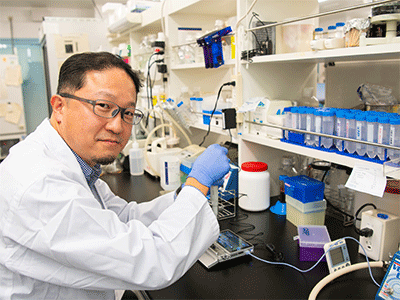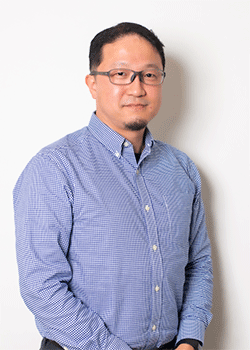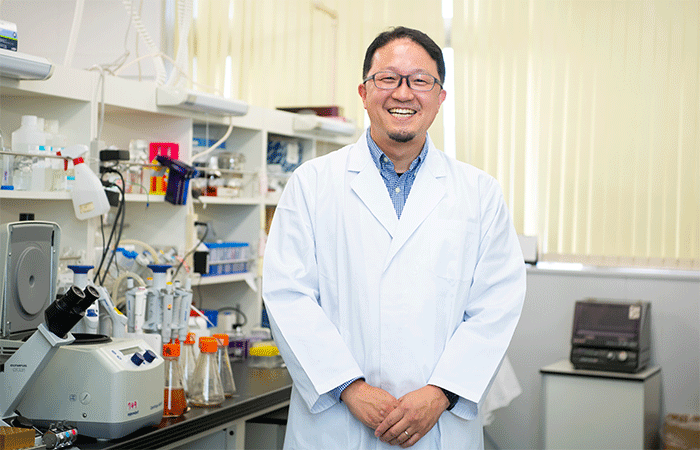Developing Testing Techniques for Genetic Materials from a User Standpoint
BRC is supported by a diverse staff who are involved in a variety of tasks. We have interviewed staff members from each of the 12 laboratories that make up BRC, asking them about their activities and their day-to-day efforts in their research rooms.
This time, we are speaking with Tetsushi Iida, a Research Scientist in the Gene Engineering Division.
Genetic materials are the most basic and indispensable research materials in bioscience research. We asked Iida, who is working to further improve the efficiency of testing technology, about his current endeavors in this field.
What inspired me to become a researcher and the creed “No Challenge, No Future!” that I keep in mind
I first became aware that researchers existed when I was a junior high school student and read Seishin to Busshitsu (Spirit and Substance), a book written by the late journalist Takashi Tachibana based on a series of dialogues he had with Dr. Susumu Tonegawa. I was impressed by the book and thought to myself, “What kind of profession is this?” This was the start of my interest in the profession of researcher.
I started thinking about becoming a researcher myself around the same time that my aunt moved to the United States and became a life science researcher. Influenced by my immediate family, I thought that it might be possible for me to pursue a PhD and pursue a research career. I am impressed by the power of genetics to imagine the existence of non-observable genes in terms of their phenotypes and to capture the reality of what is imagined, and I have been aiming to become a researcher who uses genetics to unravel the mysteries of life.
“No Challenge, No Future!”
The words that most influenced me in my life were spoken by my boss (and mentor) when I was studying in the United States as a postdoctoral researcher. After working as a postdoctoral researcher in Japan, I decided to become a postdoctoral researcher in the U.S. for the second time in the same field. When discussing research themes with my boss, I tended to be very top-heavy with ideas or information as I had a lot of experience and pride. On one such occasion when I was acting like that, my boss rebuked me with the above words.
Rather than making excuses for not trying, or saying “That approach is too hard …….,” he encouraged me to keep challenging myself in order to break down the barriers in front of me. Later, when I changed my research field, I kept his words in mind and thought to myself, “This is a big challenge,” and I was able to take on the challenge with a positive attitude.
Development of genetic materials testing technology and artificial chromosome vectors

The Gene Engineering Division operates the DNA Bank where genetic materials developed and published by researchers are deposited by each researcher, amplified, inspected for quality, stored, and provided to other researchers who wish to use these genetic materials.
I am in charge of the development of testing techniques for genetic materials. I analyze the DNA sequences of genetic materials such as plasmids deposited by researchers. One of my missions is to develop technologies for efficient testing of these materials and to implement those technologies.
I am also involved in the development of artificial chromosome vectors (genetic resource development). In an attempt to create new genetic materials, I am developing artificial chromosome vectors that can be used in a variety of organisms and cells.
Quality inspection of genetic materials is a process that involves determining the DNA sequence of genetic materials and verifying that it matches the depositor’s information. This is usually performed twice: once at the time of deposit and again at the time of provision. This is a most time-consuming and labor-intensive process, and ideally the information should be shared quickly and accurately with the research community.
One of the challenges in quality inspection is that the depositor’s own information on genetic materials they provide is not always accurate, and the actual sample may not match what would be expected from that information. In order to solve this problem, it is important to accurately share the precise full-length DNA sequence of the genetic materials in question with the depositor and make this information public to create an environment in which it is easy for users to make decisions. Therefore, in order to establish a method of obtaining the full-length DNA sequence of actual genetic materials, we are currently working on the development of a method of testing genetic materials using a next-generation sequencer (*1).
To further improve the quality of genetic materials
Joining RIKEN BRC in 2021 was a new challenge for me, although prior to that time I had been conducting research while working as an assistant professor at a university. My original specialties were genetics and molecular biology, with a focus on chromosome research. I feel that this is really the basics of basics. Although I have created a lot of genetic resources, I never really expected that anyone would use them. Even when I create something, it is only for my own research, and to help analyze a biological phenomenon that I want to know about and that no one has ever seen before.
I knew that there was a service called DNA banking, but I only thought of myself as being on the user side, and I had no idea about being on the operational side of this business. Although I managed my own products, I had never given much thought to the management conditions or the quality of products produced for general use.
Up until now, I have always been reluctant to use materials created by other people in my research. This is because, in many cases, when I received materials from private individuals, these materials did not meet my requirements and so I had to re-create them myself. To be honest, I had little knowledge of the resource business until I actually got involved.
After I started working on this project and began actually inspecting materials deposited by various researchers, I learned that there are lots of different ways to manage and create them. When we conducted tests to determine whether the information from the depositor was correct, there were many cases where we found it was incorrect, and it was a sobering realization to me that I had to correct it and release the correct information to the world. I was also reminded once again of the value of the resource business, and of the critical importance of quality control and information sharing by third parties.

The genetic materials testing method using the next-generation sequencer that we are currently developing combines data from different types of sequencers for analysis in order to accurately determine DNA sequences that are difficult for each type of sequencer to analyze independently. We expect that it will be possible to determine sequences that are difficult for the depositor who made the genetic materials to confirm. We are working to develop this technology as a means to encourage researchers to deposit their genetic materials for confirmation, and we hope that it will serve as a catalyst to help expand our network of researchers through resource projects.
What I would like to accomplish in the future is to make it possible to employ the quality inspection techniques I have developed at a low cost and with low stress. I would also like to work actively to develop research techniques that can be learned even by research assistants who have no research experience, and to educate research assistants.
- *1. Next-generation sequencer: A device that automatically reads DNA base sequence information by simultaneously analyzing a large number of DNA fragments made by cutting thread-shaped DNA, which contains the genetic information of organisms.
Profile
- Tetsushi Iida
- Research Scientist, Gene Engineering Division
- Joined RIKEN BRC in 2021. Currently, he is involved in the development of testing techniques for genetic materials and the development of artificial chromosome vectors (genetic resources development).
Release date : Dec 25, 2024
